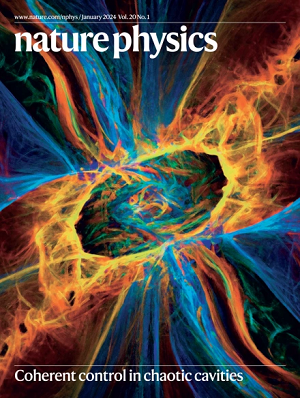水中液-液临界点位置的约束
IF 18.4
1区 物理与天体物理
Q1 PHYSICS, MULTIDISCIPLINARY
引用次数: 0
摘要
1992年首次提出了一个有趣的假设,即过冷水可以分离成两种不同的液相,每一种都有独特的结构和密度。这个想法最初是基于ST2类水经验势的数值分析,挑战了当时对水的相行为的传统理解,并从此引起了科学界的兴趣。在过去的三十年里,计算模型的进步——特别是通过数据驱动的多体势的出现,严格地从第一原理推导出来,并通过神经网络的效率得到增强——极大地提高了分子模拟的准确性,使探索水的相行为具有前所未有的真实感。我们的研究利用这些计算进步来探测过冷水中难以捉摸的液-液转变。经过数年的研究,精确到微秒级的化学模拟提供了令人信服的证据,证明水确实在低温和高压下以两种明显不同的液态存在。通过对~198 K和~ 1250 atm处液液临界点位置的精确估计,我们的研究不仅推进了目前对水异常行为的理解,而且为实验验证奠定了基础。重要的是,我们的模拟表明,液-液临界点落在温度和压力范围内,可以在纳米水滴中进行实验探测,从而为直接测量提供了可能。本文章由计算机程序翻译,如有差异,请以英文原文为准。


Constraints on the location of the liquid–liquid critical point in water
The fascinating hypothesis that supercooled water may segregate into two distinct liquid phases, each with unique structures and densities, was first posited in 1992. This idea, initially based on numerical analyses with the ST2 water-like empirical potential, challenged the conventional understanding of water’s phase behaviour at the time and has since intrigued the scientific community. Over the past three decades, advancements in computational modelling—particularly through the advent of data-driven many-body potentials rigorously derived from first principles and augmented by the efficiency of neural networks—have greatly enhanced the accuracy of molecular simulations, enabling the exploration of the phase behaviour of water with unprecedented realism. Our study leverages these computational advances to probe the elusive liquid–liquid transition in supercooled water. Microsecond-long simulations with chemical accuracy, conducted over several years, provide compelling evidence that water indeed exists in two discernibly distinct liquid states at low temperature and high pressure. By pinpointing a realistic estimate for the location of the liquid–liquid critical point at ~198 K and ~1,250 atm, our study not only advances the current understanding of water’s anomalous behaviour but also establishes a basis for experimental validation. Importantly, our simulations indicate that the liquid–liquid critical point falls within temperature and pressure ranges that could potentially be experimentally probed in water nanodroplets, opening up the possibility for direct measurements. A liquid–liquid transition in supercooled water has long been predicted. State-of-the-art simulations now precisely confine the temperature and pressure ranges for this transition, which are found to be within experimental reach.
求助全文
通过发布文献求助,成功后即可免费获取论文全文。
去求助
来源期刊

Nature Physics
物理-物理:综合
CiteScore
30.40
自引率
2.00%
发文量
349
审稿时长
4-8 weeks
期刊介绍:
Nature Physics is dedicated to publishing top-tier original research in physics with a fair and rigorous review process. It provides high visibility and access to a broad readership, maintaining high standards in copy editing and production, ensuring rapid publication, and maintaining independence from academic societies and other vested interests.
The journal presents two main research paper formats: Letters and Articles. Alongside primary research, Nature Physics serves as a central source for valuable information within the physics community through Review Articles, News & Views, Research Highlights covering crucial developments across the physics literature, Commentaries, Book Reviews, and Correspondence.
 求助内容:
求助内容: 应助结果提醒方式:
应助结果提醒方式:


